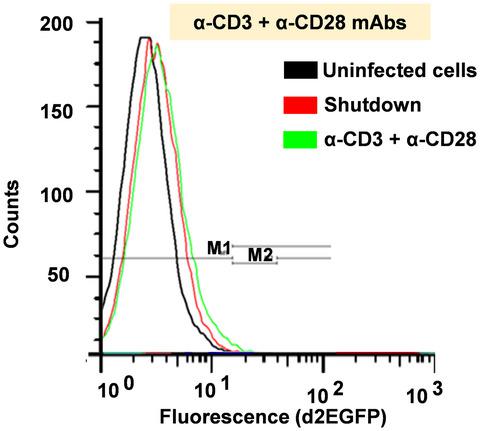当前位置:
X-MOL 学术
›
FEBS Lett.
›
论文详情
Our official English website, www.x-mol.net, welcomes your
feedback! (Note: you will need to create a separate account there.)
AP‐1 and NF‐κB synergize to transcriptionally activate latent HIV upon T‐cell receptor activation
FEBS Letters ( IF 3.0 ) Pub Date : 2021-02-09 , DOI: 10.1002/1873-3468.14033 Joseph Hokello 1 , Adhikarimayum Lakhikumar Sharma 2 , Mudit Tyagi 2
FEBS Letters ( IF 3.0 ) Pub Date : 2021-02-09 , DOI: 10.1002/1873-3468.14033 Joseph Hokello 1 , Adhikarimayum Lakhikumar Sharma 2 , Mudit Tyagi 2
Affiliation

|
Latent HIV-1 proviruses are capable of reactivating productive lytic infection, but the precise molecular mechanisms underlying emergence from latency are poorly understood. In this study, we determined the contribution of the transcription factors NF-κB, NFAT, and AP-1 in the reactivation of latent HIV following T-cell receptor (TCR) activation using Jurkat T-cell clones harboring single latent HIV proviruses. Our findings demonstrate that during reactivation from latency, NF-κB enhances HIV transcription while NFAT inhibits it by competing with NF-κB for overlapping binding sites on the HIV long terminal repeat (LTR). We have also demonstrated for the first time the molecular contribution of AP-1 in the reactivation of HIV from latency, whereby AP-1 synergizes with NF-κB to regulate HIV transcriptional elongation following TCR activation.
中文翻译:

AP-1 和 NF-κB 在 T 细胞受体激活后协同转录激活潜伏 HIV
潜伏的 HIV-1 前病毒能够重新激活生产性裂解感染,但对潜伏期出现的精确分子机制知之甚少。在这项研究中,我们使用含有单个潜伏 HIV 前病毒的 Jurkat T 细胞克隆确定了转录因子 NF-κB、NFAT 和 AP-1 在 T 细胞受体 (TCR) 激活后潜伏 HIV 再激活中的作用。我们的研究结果表明,在潜伏期重新激活期间,NF-κB 增强 HIV 转录,而 NFAT 通过与 NF-κB 竞争 HIV 长末端重复 (LTR) 上的重叠结合位点来抑制它。我们还首次证明了 AP-1 在潜伏期重新激活 HIV 中的分子贡献,其中 AP-1 与 NF-κB 协同调节 TCR 激活后的 HIV 转录延伸。
更新日期:2021-02-09
中文翻译:

AP-1 和 NF-κB 在 T 细胞受体激活后协同转录激活潜伏 HIV
潜伏的 HIV-1 前病毒能够重新激活生产性裂解感染,但对潜伏期出现的精确分子机制知之甚少。在这项研究中,我们使用含有单个潜伏 HIV 前病毒的 Jurkat T 细胞克隆确定了转录因子 NF-κB、NFAT 和 AP-1 在 T 细胞受体 (TCR) 激活后潜伏 HIV 再激活中的作用。我们的研究结果表明,在潜伏期重新激活期间,NF-κB 增强 HIV 转录,而 NFAT 通过与 NF-κB 竞争 HIV 长末端重复 (LTR) 上的重叠结合位点来抑制它。我们还首次证明了 AP-1 在潜伏期重新激活 HIV 中的分子贡献,其中 AP-1 与 NF-κB 协同调节 TCR 激活后的 HIV 转录延伸。











































 京公网安备 11010802027423号
京公网安备 11010802027423号